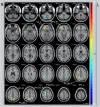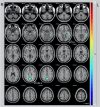Therapy effect of cochleural alternating acoustic beam therapy versus traditional sound therapy for managing chronic idiopathic tinnitus patients
- PMID: 38467716
- PMCID: PMC10928112
- DOI: 10.1038/s41598-024-55866-0
Therapy effect of cochleural alternating acoustic beam therapy versus traditional sound therapy for managing chronic idiopathic tinnitus patients
Abstract
Idiopathic tinnitus is a common and complex disorder with no established cure. The CAABT (Cochleural Alternating Acoustic Beam Therapy CAABT), is a personalized sound therapy designed to target specific tinnitus frequencies and effectively intervene in tinnitus according to clinical tinnitus assessment. This study aimed to compare the effectiveness of the CAABT and Traditional Sound Therapy (TST) in managing chronic idiopathic tinnitus. This was a randomized, double-blind, parallel-group, single-center prospective study. Sixty adult patients with tinnitus were recruited and randomly assigned to the CAABT or TST group in a 1:1 ratio using a computer-generated randomization. The treatment lasted for 12 weeks, and participants underwent assessments using the tinnitus handicap inventory (THI), visual analog scale (VAS), tinnitus loudness measurements, and resting-state functional magnetic resonance imaging (rs-fMRI). Both groups showed significant reductions in THI scores, VAS scores, and tinnitus loudness after treatment. However, CAABT showed superiority to TST in THI Functional (p = 0.018), THI Emotional (p = 0.015), THI Catastrophic (p = 0.022), THI total score (p = 0.005) as well as VAS score (p = 0.022). More interesting, CAABT showed superiority to TST in the changes of THI scores, and VAS scores from baseline. The rs-fMRI results showed significant changes in the precuneus before and after treatment in both groups. Moreover, the CAABT group showed more changes in brain regions compared to the TST. No side effects were observed. These findings suggest that CAABT may be a promising treatment option for chronic idiopathic tinnitus, providing significant improvements in tinnitus-related symptoms and brain activity.Trial registration: ClinicalTrials.gov:NCT02774122.
Keywords: Chronic idiopathic tinnitus; Cochleural alternating acoustic beam therapy; Randomized controlled clinical trial; Sound therapy.
© 2024. The Author(s).
Conflict of interest statement
The authors declare no competing interests.
Figures




Similar articles
-
The Cochleural Alternating Acoustic Beam Therapy (CAABT): A pre-clinical trial.Am J Otolaryngol. 2018 Jul-Aug;39(4):401-409. doi: 10.1016/j.amjoto.2018.04.002. Epub 2018 Apr 3. Am J Otolaryngol. 2018. PMID: 29655489 Clinical Trial.
-
Refined Sound Therapy in Combination with Cognitive Behavioural Therapy to Treat Tinnitus: A Randomized Controlled Trial.Altern Ther Health Med. 2024 Nov;30(11):28-33. Altern Ther Health Med. 2024. PMID: 38518137 Clinical Trial.
-
[A double-blind randomized controlled trial on the efficacy of mixed pure tone sound therapy in chronic tinnitus patients with different hearing loss].Zhonghua Er Bi Yan Hou Tou Jing Wai Ke Za Zhi. 2019 May 7;54(5):355-361. doi: 10.3760/cma.j.issn.1673-0860.2019.05.008. Zhonghua Er Bi Yan Hou Tou Jing Wai Ke Za Zhi. 2019. PMID: 31137095 Clinical Trial. Chinese.
-
Sound therapy (using amplification devices and/or sound generators) for tinnitus.Cochrane Database Syst Rev. 2018 Dec 27;12(12):CD013094. doi: 10.1002/14651858.CD013094.pub2. Cochrane Database Syst Rev. 2018. PMID: 30589445 Free PMC article.
-
A State-of-the-Art Review: Personalization of Tinnitus Sound Therapy.Front Psychol. 2017 Sep 20;8:1599. doi: 10.3389/fpsyg.2017.01599. eCollection 2017. Front Psychol. 2017. PMID: 28970812 Free PMC article. Review.
References
Publication types
MeSH terms
Associated data
Grants and funding
LinkOut - more resources
Full Text Sources
Medical

